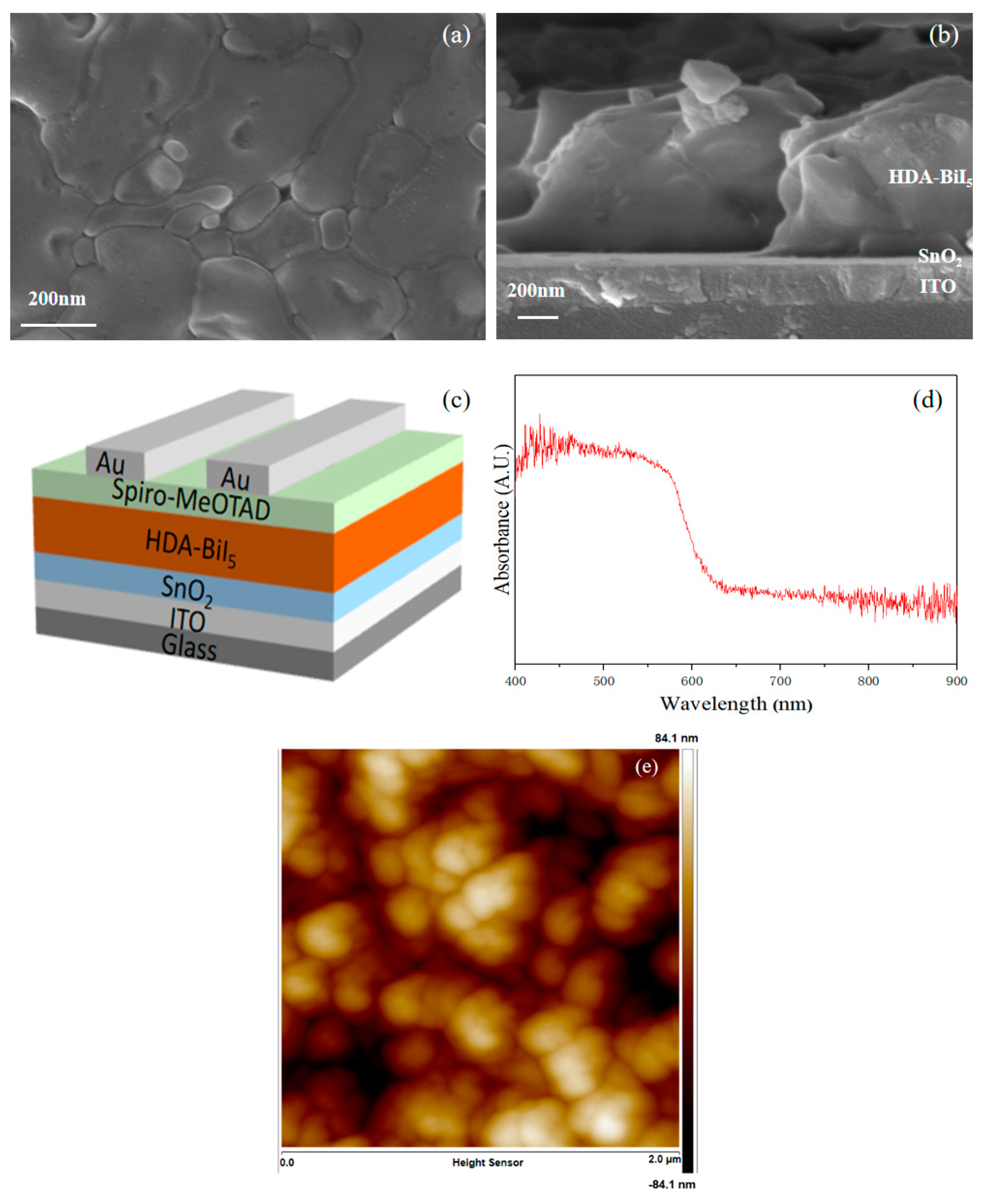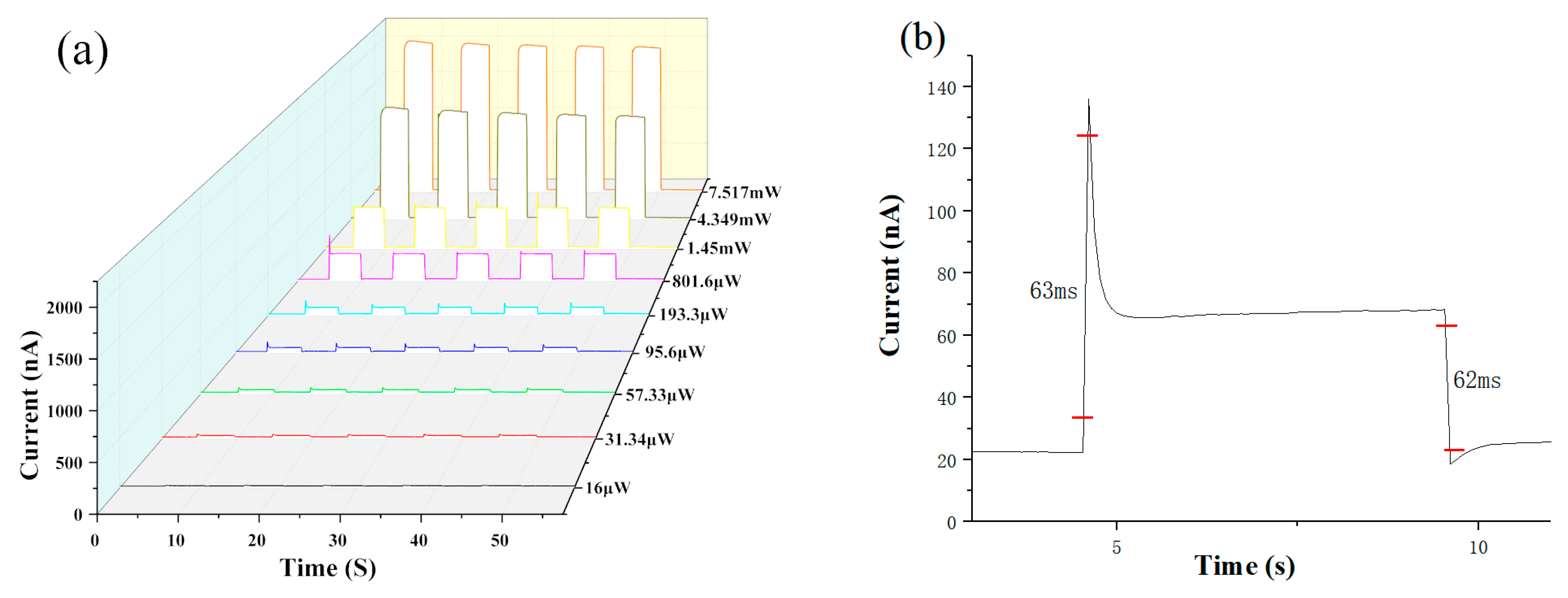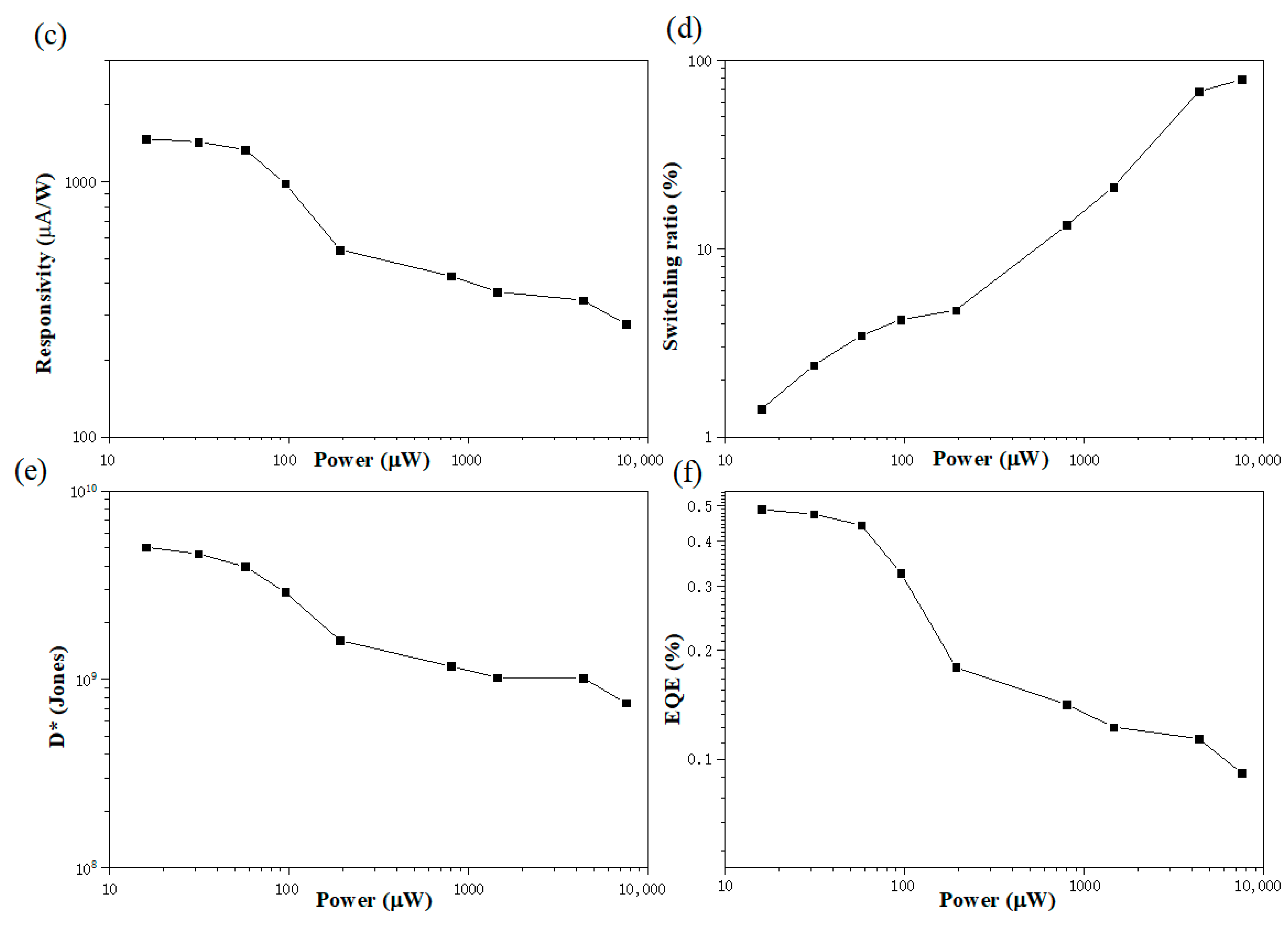Investigation of the Photoresponse and Time-Response Characteristics of HDA-BiI5-Based Photodetectors
Abstract
:1. Introduction
2. Experimental
2.1. Device Fabrication
2.1.1. Preparation of Electron Transport Layer
2.1.2. Preparation of Light-Absorbing Layer
2.1.3. Preparation of Hole Transport Layer
2.1.4. Preparation of Electrodes
3. Results and Discussion
4. Conclusions
Author Contributions
Funding
Institutional Review Board Statement
Informed Consent Statement
Data Availability Statement
Conflicts of Interest
References
- Fan, M.M.; Liu, K.W.; Zhang, Z.Z.; Li, B.H.; Chen, X.; Zhao, D.X.; Shan, C.X.; Shen, D.Z. High-performance solar-blind ultraviolet photodetector based on mixed-phase ZnMgO thin film. Appl. Phys. Lett. 2014, 105, 011117. [Google Scholar] [CrossRef] [Green Version]
- Ma, S.; Feng, S.; Kang, S.; Wang, F.; Fu, X.; Lu, W. A High Performance Solar-Blind Detector Based on Mixed–Phase Zn0.45Mg0.55O Alloy Nanowires Network. Electron. Mater. Lett. 2019, 15, 303–313. [Google Scholar] [CrossRef]
- Wang, L.; Zhao, D.; Su, Z.; Fang, F.; Li, B.; Zhang, Z.; Shen, D.; Wang, X. High spectrum selectivity organic/inorganic hybrid visible-blind ultraviolet photodetector based on ZnO nanorods. Org. Electron. 2010, 11, 1318–1322. [Google Scholar] [CrossRef]
- Gong, X.; Tong, M.; Xia, Y.; Cai, W.; Moon, J.S.; Cao, Y.; Yu, G.; Shieh, C.-L.; Nilsson, B.; Heeger, A.J. High-Detectivity Polymer Photodetectors with Spectral Response from 300 nm to 1450 nm. Science 2009, 325, 1665–1667. [Google Scholar] [CrossRef] [PubMed]
- Zheng, M.J.; Xu, Y.L.; Wang, X.; Zhang, G.Z.; Li, W.; Jiang, L.; Zhang, L.; Wu, H.; Lin, Q.Q.; Liu, C. ZnO-Based Ultraviolet Photodetectors with Tunable Spectral Responses. Phys. Status Solidi-Rapid Res. Lett. 2019, 13, 7. [Google Scholar] [CrossRef]
- Zhu, L.; Dai, Q.; Hu, Z.-F.; Zhang, X.-Q.; Wang, Y.-S. Organic Deep Ultraviolet Photodetector with Response Peak Focusing on 270 nm Using the Acceptor BAlq. IEEE Photonics Technol. Lett. 2011, 23, 1835–1837. [Google Scholar] [CrossRef]
- Ma, N.; Yang, Y. Enhanced self-powered UV photoresponse of ferroelectric BaTiO3 materials by pyroelectric effect. Nano Energy 2017, 40, 352–359. [Google Scholar] [CrossRef]
- Chen, J.; Priya, A.S.; You, D.; Pei, W.; Zhang, Q.; Lu, Y.; Li, M.; Guo, J.; He, Y. Self-driven ultraviolet photodetectors based on ferroelectric depolarization field and interfacial potential. Sens. Actuators A Phys. 2020, 315, 112267. [Google Scholar] [CrossRef]
- Zhang, H.-Y.; Wei, Z.; Li, P.-F.; Tang, Y.-Y.; Liao, W.-Q.; Ye, H.-Y.; Cai, H.; Xiong, R.-G. The Narrowest Band Gap Ever Observed in Molecular Ferroelectrics: Hexane-1,6-diammonium Pentaiodobismuth(III). Angew. Chem. Int. Ed. 2017, 57, 526–530. [Google Scholar] [CrossRef]
- Fabian, D.M.; Ardo, S. Hybrid organic–inorganic solar cells based on bismuth iodide and 1,6-hexanediammonium dication. J. Mater. Chem. A 2016, 4, 6837–6841. [Google Scholar] [CrossRef]
- Liu, X.; Zhang, G.; Zhu, M.; Chen, W.; Zou, Q.; Zeng, T. Polarization-enhanced photoelectric performance in a molecular ferroelectric hexane-1,6-diammonium pentaiodobismuth (HDA-BiI5)-based solar device. RSC Adv. 2020, 10, 1198–1203. [Google Scholar] [CrossRef] [Green Version]
- Wang, Y.; Zou, X.; Zhu, J.; Zhang, C.; Cheng, J.; Wang, J.; Wang, X.; Li, X.; Song, K.; Ren, B.; et al. Photodetector without Electron Transport Layer Based on Hexane-1,6-Diammonium Pentaiodobismuth (HDA-BiI5) Molecular Semiconductor. Coatings 2021, 11, 1099. [Google Scholar] [CrossRef]
- Arredondo, B.; de Dios, C.; Vergaz, R.; Criado, A.; Romero, B.; Zimmermann, B.; Würfel, U. Performance of ITO-free inverted organic bulk heterojunction photodetectors: Comparison with standard device architecture. Org. Electron. 2013, 14, 2484–2490. [Google Scholar] [CrossRef]
- Chang, Y.-M.; Leu, C.-Y. Conjugated polyelectrolyte and zinc oxide stacked structure as an interlayer in highly efficient and stable organic photovoltaic cells. J. Mater. Chem. A 2013, 1, 6446–6451. [Google Scholar] [CrossRef]
- Hau, S.K.; Yip, H.L.; Hong, M.; Jen, K.Y. High performance ambient processed inverted polymer solar cells through interfacial modification with a fullerene self-assembled monolayer. Appl. Phys. Lett. 2008, 93, 441. [Google Scholar] [CrossRef]
- Sun, Y.; Seo, J.H.; Takacs, C.J.; Seifter, J.; Heeger, A.J. Inverted Polymer Solar Cells Integrated with a Low-Temperature-Annealed Sol-Gel-Derived ZnO Film as an Electron Transport Layer. Adv. Mater. 2011, 23, 1679–1683. [Google Scholar] [CrossRef] [PubMed]
- Yang, T.; Cai, W.; Qin, D.; Wang, E.; Lan, L.; Gong, X.; Peng, J.; Cao, Y. Solution-Processed Zinc Oxide Thin Film as a Buffer Layer for Polymer Solar Cells with an Inverted Device Structure. J. Phys. Chem. C 2010, 114, 6849–6853. [Google Scholar] [CrossRef]
- Zhang, G.; Zhang, Q.; Hu, Q.; Wang, B.; Yang, W. Giant enhancements in electronic transport and photoelectric properties of bismuth oxysulfide by pressure-driven 2D–3D structural reconstruction. J. Mater. Chem. A 2019, 7, 4019–4025. [Google Scholar] [CrossRef]
- He, Z.; Zhong, C.; Huang, X.; Wong, W.-Y.; Wu, H.; Chen, L.; Su, S.; Cao, Y. Simultaneous Enhancement of Open-Circuit Voltage, Short-Circuit Current Density, and Fill Factor in Polymer Solar Cells. Adv. Mater. 2011, 23, 4636–4643. [Google Scholar] [CrossRef]
- Huangfu, G.; Xiao, H.; Guan, L.; Zhong, H.; Hu, C.; Shi, Z.; Guo, Y. Visible or Near-Infrared Light Self-Powered Photodetectors Based on Transparent Ferroelectric Ceramics. ACS Appl. Mater. Interfaces 2020, 12, 33950–33959. [Google Scholar] [CrossRef]
- Ma, N.; Zhang, K.; Yang, Y. Photovoltaic–Pyroelectric Coupled Effect Induced Electricity for Self-Powered Photodetector System. Adv. Mater. 2017, 29, 10. [Google Scholar] [CrossRef] [PubMed]
- Qi, J.; Ma, N.; Yang, Y. Photovoltaic-Pyroelectric Coupled Effect Based Nanogenerators for Self-Powered Photodetector System. Adv. Mater. Interfaces 2018, 5, 8. [Google Scholar] [CrossRef]
- Ma, N.; Yang, Y. Boosted photocurrent in ferroelectric BaTiO3 materials via two dimensional planar-structured contact configurations. Nano Energy 2018, 50, 417–424. [Google Scholar] [CrossRef]
- Song, K.; Ma, N.; Mishra, Y.; Adelung, R.; Yang, Y. Achieving Light-Induced Ultrahigh Pyroelectric Charge Density toward Self-Powered UV Light Detection. Adv. Electron. Mater. 2019, 5, 8. [Google Scholar] [CrossRef] [Green Version]
- Shen, T.; Chu, Y.; Liao, Y.; Lee, W.; Kuo, H.; Lin, T.; Chen, Y. Ultrahigh-Performance Self-Powered Flexible Photodetector Driven from Photogating, Piezo-Phototronic, and Ferroelectric Effects. Adv. Opt. Mater. 2020, 8, 1901334. [Google Scholar] [CrossRef]
- Ghatak, S.; Pal, A.N.; Ghosh, A. Nature of Electronic States in Atomically Thin MoS2 Field-Effect Transistors. ACS Nano 2011, 5, 7707–7712. [Google Scholar] [CrossRef] [PubMed] [Green Version]




| Photodetector | ETL (Yes/No) | Polarization (Yes/No) | Light (nm) | Dark- Current (pA) | Responsivity (A/W) | Detectivity [Jones] | Rise and Decay Time (s) | Ref. |
|---|---|---|---|---|---|---|---|---|
| BaTiO3 | No | No | 365 | - | 3.48 × 10−9 | 2.06 × 104 | - | [7] |
| PLZT8 | No | No | 405 | >22 | 4.48 × 10−7 | 7.15 × 107 | - | [20] |
| BaTiO3 | No | No | 405 | >100 | <3.5 × 10−7 | <3.5 × 105 | 0.4/1.6 | [21] |
| BiFeO3 | No | Yes | 450 | >100 | ~10−7 | ~108 | 0.5/0.8 | [22] |
| PLZT | No | Yes | 375 | 3 | <5 × 10−5 | <9.52 × 108 | >0.42/0.46 | [8] |
| No | Yes | 532 | <2.5 × 10−5 | <9.52 × 108 | 0.42/0.46 | |||
| No | Yes | 375 | 2 2 | <1 × 10−4 | <3.69 × 109 | 0.34/0.36 | ||
| No | Yes | 532 | <2.5 × 10−5 | <3.69 × 109 | >0.34/0.36 | |||
| BaTiO3 | No | No | 405 | - | ∼10−7 | 105 | 0.6/0.5 | [23] |
| BaTiO3 | No | No | 365 | - | ∼10−7 | - | 0.56/13.44 | [24] |
| TiO2:P3HT | Yes (TiO2) | No | 375 | >103 | <5 × 10−4 | <10−8 | >0.52/0.87 | [25] |
| Yes (TiO2) | No | 532 | <4.5 × 10−4 | <10−8 | >0.52/0.87 | |||
| HDA-BiI5 | Yes (TiO2) | Yes | Sunlight illumination | - | - | - | - | [11] |
| HDA-BiI5 | Yes (TiO2) | No | Sunlight illumination | - | - | - | - | [10] |
| HDA-BiI5 | No | No | 375 | 16 | 5.37 × 10−4 | 5.9 × 1010 | 0.061/0.062 | [12] |
| No | No | 532 | 1.28 × 10−4 | 1.4 × 1010 | 0.062/0.063 | |||
| HDA-BiI5 | Yes (SnO2) | No | 375 | 20 | 1.45 × 10−3 | 5.0 × 109 | 0.063/0.062 | This work |
| Yes (SnO2) | No | 532 | 8.5 × 10−4 | 3.2 × 109 | 0.062/0.064 |
Publisher’s Note: MDPI stays neutral with regard to jurisdictional claims in published maps and institutional affiliations. |
© 2021 by the authors. Licensee MDPI, Basel, Switzerland. This article is an open access article distributed under the terms and conditions of the Creative Commons Attribution (CC BY) license (https://creativecommons.org/licenses/by/4.0/).
Share and Cite
Wang, Y.; Zou, X.; Zhu, J.; Zhang, C.; Cheng, J.; Wang, J.; Wang, X.; Li, X.; Song, K.; Ren, B.; et al. Investigation of the Photoresponse and Time-Response Characteristics of HDA-BiI5-Based Photodetectors. Materials 2022, 15, 321. https://doi.org/10.3390/ma15010321
Wang Y, Zou X, Zhu J, Zhang C, Cheng J, Wang J, Wang X, Li X, Song K, Ren B, et al. Investigation of the Photoresponse and Time-Response Characteristics of HDA-BiI5-Based Photodetectors. Materials. 2022; 15(1):321. https://doi.org/10.3390/ma15010321
Chicago/Turabian StyleWang, Yifei, Xiaoping Zou, Jialin Zhu, Chunqian Zhang, Jin Cheng, Junqi Wang, Xiaolan Wang, Xiaotong Li, Keke Song, Baokai Ren, and et al. 2022. "Investigation of the Photoresponse and Time-Response Characteristics of HDA-BiI5-Based Photodetectors" Materials 15, no. 1: 321. https://doi.org/10.3390/ma15010321
APA StyleWang, Y., Zou, X., Zhu, J., Zhang, C., Cheng, J., Wang, J., Wang, X., Li, X., Song, K., Ren, B., & Li, J. (2022). Investigation of the Photoresponse and Time-Response Characteristics of HDA-BiI5-Based Photodetectors. Materials, 15(1), 321. https://doi.org/10.3390/ma15010321








